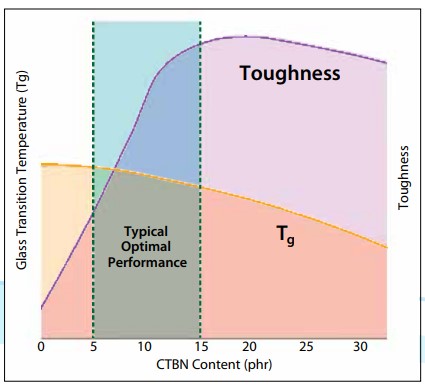Guest post by Jeremy Pasatta, Advanced Polymer Coatings
In the previous blog post, we explored the reasons why thermosets benefit from the addition of second phase tougheners. One of the most successful and widely used forms of second phase tougheners is Reactive Liquid Polymers, or RLP. RLP can be any polymer that is low enough in molecular weight to be able to flow at room temperature, and they also have sites capable of reacting with the matrix resin. Initially, these polymers are compatible with the matrix resin and form a one phase homogeneous system. As the curing reaction proceeds and the RLP reacts into the matrix resin, the molecular weight of the RLP grows to the point where they become immiscible, phase separating and forming a second domain toughener. This process is known as Reaction Induced Phase Separation, or RIPS. Perhaps the most classic example of RLP are a group of polybutadiene-acrylonitrile copolymers that have carboxylic acid groups at the end of the polymers chains, which is termed a telechelic polymer and commonly go by the abbreviation CTBN. The general structure of CTBN is given in Figure 1.
Figure 1. Structure of CTBN tougheners
The functionality of these polymers is approximately 1.9 with the functional groups being located at the end of the polymer chains, and the molecular weight (Mn) of these polymers is approximately 3,000 – 4,000. The butadiene is chosen to give the polymer low Tg and allow for easy particle cavitation, even at temperatures as low as -40˚C. Acrylonitrile is added primarily to improve the initial miscibility of the polymers in the matrix resin. Polybutadiene is extremely non-polar and possesses a very low solubility parameter. Because of the low solubility parameter mismatch with most epoxy resins, pure polybutadiene will macrophase separate from the matrix resin even before the curing process is started. Acrylonitrile increases the polarity of the polymer and increases the solubility parameter, thereby increasing the initial solubility in epoxy or matrix resin. Typical acrylonitrile content ranges from 10-26%, with the distribution of butadiene and acrylonitrile monomers being completely random through the polymer chain. The major advantages and disadvantages of acrylonitrile in CTBN are:
Advantages of acrylonitrile in CTBN
- Increases initial solubility of CTBN in resin
- Improves adhesion to substrates, especially oily substrates
Disadvantages of acrylonitrile in CTBN
- Increases viscosity of neat CTBN
- Can decrease Tg and modulus of matrix resin
- Decreases effectiveness of low temperature toughening
Figure 2 shows viscosity as a function of acrylonitrile content for the neat CTBNs and shows how viscous these polymers become when the acrylonitrile content reaches 26%. The most common acrylonitrile level for CTBN tougheners is 18% or 26%, and it can be seen that adding these high viscosity polymers to formulations can also increase the overall formulation viscosity.
Figure 2. Viscosity of CTBN as a Function of Acrylonitrile Content
As listed above, increasing acrylonitrile content and initial solubility of the CTBN decreases the amount of CTBN that phase separates from the matrix. If the polymer does not phase separate and remains dissolved in the matrix resin, the Tg of the matrix resin will be lower, and some of the high temperature properties and modulus will be lost. Increasing acrylonitrile content also increases the Tg of the copolymer, and therefore decreases the effective toughening at low temperatures. Figure 3 gives a general schematic of optimizing toughening using CTBN. The toughness is usually optimized at 5-15 phr of toughener, which also maximizes the amount of phase separated polymer and minimizes the effect on the Tg of the matrix resin.
Figure 3. Optimizing Performance of CTBN
(Source: CVC Product Brochure)
The carboxylic acid group of CTBN can be derived into a variety of chemistries to enhance reactivity in various systems. By enhancing reactivity, the RLP more quickly reacts into the matrix, which enhances phase separation, increases toughening, and limits the Tg depression. Table 1 gives the various derivatives that are commercially available, along with what type of applications they are commonly used in.
TABLE 1. CTBN Derivatives and Application Areas
This blog post showed one type of toughener, CTBN, which forms a second phase domain through RIPs. In the next blog post, we will examine another type of rubbery low modulus toughener that toughens through a second phase morphology (coreshell particles) and will compare these two toughening technologies that are widely used in the thermoset industry.





Leave a Reply